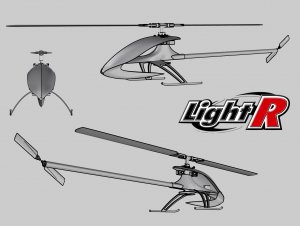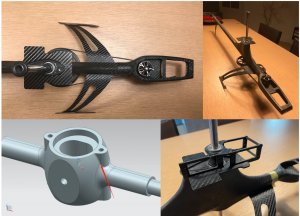I promised some more details, here they are.
My Light'R 700 is inspired by the moulding methods used by carbon bicycles.
Purpose was not to have the absolute lightest, but something that would be substantially lighter than usual while still being capable of the mild 3D stuff I do. Blade grips are small ones from Mikado, DIY blades are in the planning (since years...) but now I use the relatively light TDSF from Henseleit. Design is around a 500Watt main motor (TDSF is 1000 Watt) and a 200 Watt tail. Ambition was around 1800 grams, but a better weight distribution (lighter at the back) I may end up with a smaller battery around 1600 grams. The tail motor is oversized, but that is because I want low RPM so I need high torque. I hate the noise of a small tail . Especially when constantly changing RPM due to the gyro and compensation. Tail prop is 12", although If that works I may go to 13". Should turn at 3000-4000 rpm max. Disadvantage is that inertia may fight with the response rate of the gyro. We'll see. Just like my 7 years old Light'R 600, it's belt driven for the main rotor, and direct drive in the tail. The rotor hub is CNC machined. You may think it's based on TDSF, but it's a design that was actually typical in 1970-80 tail rotors where a silicon/rubber sleeve was used to dampen gyroscopic precession on the tail. I included adjustable stiffness. It has 2 rubber rings that can be squeezed with the carbon plates. Tightening the bolts gives harder damping. I have rubber rings in different hardness ('shore') so it's pretty flexible system for prototyping and testing a variety of RPM and blade combinations. We'll see how that works. The main ESC is a 35A from YGE that has a very good governor (target is 700-900 rpm). Tail esc is from T-Motor, have very good response rate important for gyro. The whole design was threaded as a piece of art as much as a piece of mechanics. I choose the servos such that the color of the connector wires fits with the carbon. I know, does not change anything's except in my perception

 Wie ich bereits schrieb: Dies ist die aufregendste Entwicklung bei RC-Helikoptern, die ich seit Jahrzehnten gesehen habe. Zu Ihrer Information: Ich fliege seit ca. 7 Jahren mein eigenes Design "Light'R" 600 Format mit weniger als 1400 Gramm und 3S 2200mAh. Eine neue 700-800er-Version, mit viel Fokus auf das Aussehen, ist fast fertig, wird etwa 1600 Gramm wiegen, viel schwerer als das was ich hier sehe, aber immer noch 1 kg leichter als der TDSF für (hoffentlich) vergleichbare Leistung.
Wie ich bereits schrieb: Dies ist die aufregendste Entwicklung bei RC-Helikoptern, die ich seit Jahrzehnten gesehen habe. Zu Ihrer Information: Ich fliege seit ca. 7 Jahren mein eigenes Design "Light'R" 600 Format mit weniger als 1400 Gramm und 3S 2200mAh. Eine neue 700-800er-Version, mit viel Fokus auf das Aussehen, ist fast fertig, wird etwa 1600 Gramm wiegen, viel schwerer als das was ich hier sehe, aber immer noch 1 kg leichter als der TDSF für (hoffentlich) vergleichbare Leistung.




